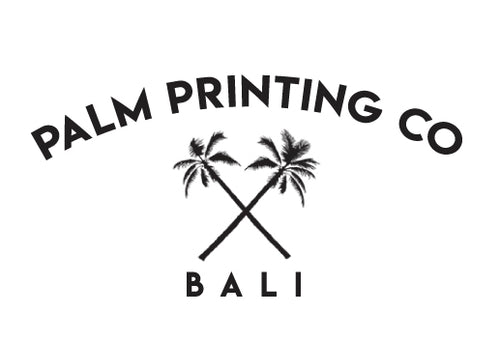Effective Stain Removal Techniques for Fabrics: Tried and Tested Methods
As a second-generation clothing manufacturer and the founders of Yogi and Boo—an ethically certified clothing factory in Bali that has been in business for over 35 years—we understand the importance of maintaining our fabrics. Additionally, we are the creators of Palm Printing Co, an ethically and sustainably certified digital textile company. With both factories located in Bali, Indonesia, we have accumulated a wealth of experience in fabric care. In this blog post, we will share tried and tested techniques that have worked for us in the past when it comes to removing stains. Keep in mind that results may vary depending on the fabric and type of stain.
Stain Removal Methods for Oily Marks
When it comes to oil stains, speed is of the essence. Here's how you can effectively remove sewing machine oil and other oil-based stains from your fabrics.
Method 1: Talcum Powder or Baby Powder
- Step 1: Sprinkle talcum or baby powder over the oil stain.
- Step 2: Gently dab the powder into the stain, being careful not to rub too hard.
- Step 3: Dust off the excess powder and check the stain's progress.
This method may require several repetitions, but it is our favorite for removing oil stains from fabric. If talcum powder isn't available, baking soda can serve as a great alternative due to its oil-absorbing properties.
Method 2: Dishwashing Detergent
- Step 1: Apply a small amount of dishwashing detergent directly to the oil stain.
- Step 2: Use a damp sponge to dab the stain from both the front and underside.
- Step 3: Rinse and repeat as necessary until the stain is removed.
This method works well for fresh oil stains and can be particularly effective when combined with other approaches.
Tackling Wine, Food and Sauce Stains
Wine, food and sauce stains can be particularly stubborn as they are generally a combination of but with the right strategy, they don’t stand a chance.
Method 1: Baking Soda and Detergent Paste
- Step 1: Create a paste by mixing baking soda with liquid detergent.
- Step 2: Dab the paste onto the underside of the stained fabric.
- Step 3: Allow it to absorb for a few minutes, then rinse out.
This technique can effectively lift wine and sauce stains from your fabrics. For tougher stains, you can enhance the paste's effectiveness by adding white vinegar.
Method 2: Baking Soda, Detergent, and Vinegar
- Step 1: With the paste already on the fabric, carefully add white vinegar.
- Step 2: Watch as the two ingredients react; this bubbling action helps lift stains.
Before applying this method to your fabric, always conduct a patch test on a small, inconspicuous area. Remember, certain vinegars can change the color of the fabric, and it’s crucial to allow the test area to dry fully for accurate comparison.
H2: Dye Stains from Accidentally Washing Lights and Darks Together
Accidental dye transfer can occur when washing light and dark fabrics together. Here's how to address these stains effectively.
-
Tip 1: Ensure the item has not dried yet and is still damp. This helps the process, as the colors might not be entirely bonded to the fibers.
-
Tip 2: DO NOT use bleach unless it's a white garment (and this means no prints or any colors).
-
Step 1 for White Garments: If it is a completely white garment/item of clothing, mix 5ml of bleach in 3-4 liters of water. Soak the item for a few hours to slowly remove the color. It’s best to do multiple diluted steps over 3-4 times rather than using a strong mixture, which may break down the fabric fibers.
-
Step 2 for Colored Items: If it's a colored or printed item, start with a mixture of 10-15ml of hydrogen peroxide in 3-4 liters of water. Do multiple soaks with small increments of strength. For example, the next soak could be 15-20ml in 3-4 liters.
-
Tip 3: Removing back staining is a slow process and will typically take multiple washes and soaks. In most cases, the color will eventually come out, as it’s unlikely to have fully bonded to the fabric fibers.
H2: Pro Tips for Optimal Results
To maximize stain removal effectiveness, keep these professional tips in mind:
Act Quickly
The best results occur when the stain is still fresh and the fabric has not yet been washed. Keep the fabric damp and do not let the stain completely dry. Tackling stains promptly is key!
Wash Entire Item
After spot cleaning, wash the entire item while it's still damp to prevent water stains in the cleaned area. Once a stain has dried, it becomes significantly more difficult to remove.
Dab, Don’t Rub
When dealing with stains, use a dabbing motion rather than rubbing or wiping the fabric. Rubbing can damage the fabric and make the stain worse, especially when it comes to printed materials. Always try to rub from the inside or underside of the fabric to protect surface prints.
Hydrogen Peroxide Solution
For chemical-based stains such as dyes, rubbing from other colours/fabrics etc, consider using a solution of 10-15ml of 5% hydrogen peroxide mixed into 3-4 liters of water. This acts as an oxidizer and can effectively lift many stubborn stains.
Conclusion
Stains may be a common occurrence, but with these effective stain removal methods, you can keep your fabrics looking fresh and clean. Always remember to test techniques on an inconspicuous area and act quickly for the best results. With a little patience and the right approach, you can remove even the toughest stains. Happy cleaning!
Satria.


